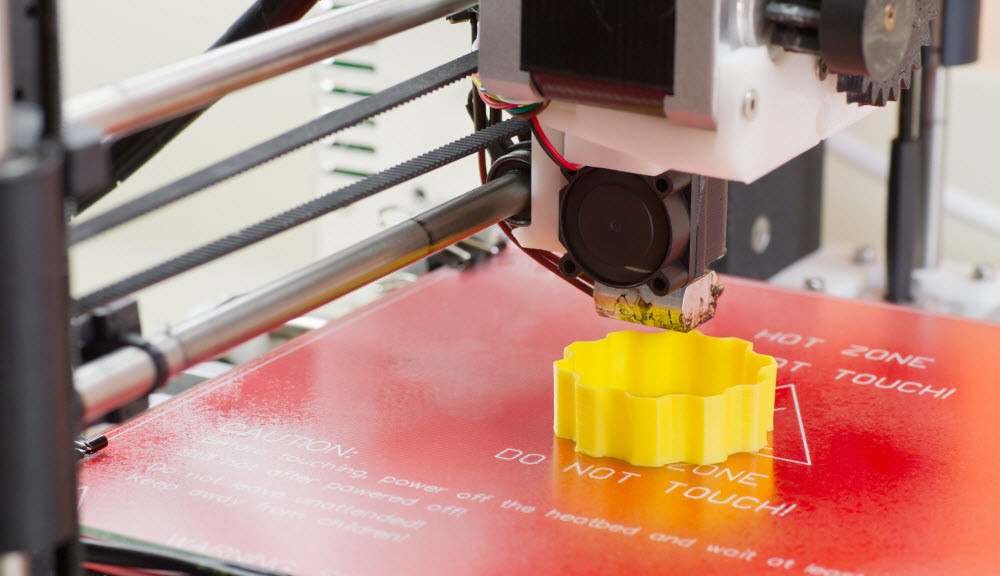A bogeyman or an opportunity?
Sneakers, spare parts, sugary treats, or even a 3D model of a human heart: hardly a week goes by without a new 3D-printed product making headlines. It's no wonder, then, that companies across a wide range of industries are now exploring the use of 3D printers. Logistics providers are also launching initial pilot projects to determine whether and how this new technology will impact their business models.
It is clear that the market share of additive manufacturing (the production of articles or parts using 3D printing technologies) will continue to grow in the future. However, it is still completely unclear when and to what extent this production technology will be able to complement or even replace traditional manufacturing processes.
application areas
Simply constructed items
Plastic cutlery, buttons, screws, or pen casings: these are all simple goods that are already being produced using 3D printers. Due to the low labor costs and minimal personnel required for the automated production of these parts, they can be manufactured economically even in high-wage countries like Germany. For technically simple items and components, the technology is therefore already relatively easy to implement. Karl Gernandt, Chairman of the Board of Directors of the logistics company Kühne & Nagel , anticipates that, with the continued development of 3D printing technology, a significant proportion of mass-produced goods will be manufactured locally in Germany in the future, instead of coming from factories in the Far East.
spare parts
3D printing could usher in a completely new era of warehousing. Instead of maintaining a large inventory of spare parts at all times, parts could be printed on demand only when needed. This would allow for precise control over timing and quantity. Complex ordering processes would be eliminated, as the print job would simply be sent to the machines. Automated solutions are even conceivable, where systems would autonomously place orders when a certain minimum quantity of parts is reached.
Slow-moving
Infrequently requested C-parts, which currently occupy an unnecessarily large amount of storage space but must be permanently available for service reasons, for example, could in the future only be printed when needed. This would save valuable space and keep storage costs down.
Prototypes
Prototypes can also be easily created. Instead of laboriously casting molds or adjusting and resetting machines, a USB stick containing the 3D model of the part is all that's needed to start printing. 3D printing can also be used to print virtually any geometric shape that can be represented three-dimensionally. This makes it possible to produce product shapes that were previously either impossible or prohibitively expensive to reproduce.
3D printing technology also enables companies to manufacture customized products on demand. Even the production of small batches of individual parts can be economically viable using this method.
Production tools for industry
The car manufacturer VW is already producing some assembly aids and production tools using 3D printing. After extensive testing, these have been put into series production at the Wolfsburg plant.
Companies may still have some way to go before they can achieve on-demand production without warehouses or tools, but the first steps have been taken.
Impact on logistics
The list shows that companies would be well advised to prepare themselves now for the opportunities and challenges of this new technology. It is clear that these machines make it relatively easy to produce articles and parts of various designs and shapes.
Of course, alongside all the possibilities, 3D printing also carries risks. For example, counterfeit products can be circulated, sometimes with dangerous consequences. Counterfeits are also easy to produce once unauthorized individuals gain access to the printing data. Furthermore, the materials used often lack sufficient wear or fracture resistance. The material properties of identical parts printed consecutively also often vary slightly. This leads to inconsistent quality and renders the parts unsuitable for many applications.
Decentralized production
Does 3D printing still have the potential to transform the logistics of tomorrow? Besides boosting Germany as a production location, the just-in-time printing of less frequently needed spare parts, components, and other slow-moving items would initially reduce the need for storage space. This is good news for companies that generally struggle with increasing quantities of goods in storage; less good news for logistics providers, who would consequently face declining demand for their warehouse space and transport services.
However, logistics companies could easily turn the tables by making themselves pioneers of the new technology.
Logistics companies as 3D printing service providers
Opportunities are particularly evident in the area of spare parts logistics. If parts are manufactured using 3D printing in the future, it's likely that not every manufacturer will feel confident in their ability to supply these items in the required quantity and quality. Therefore, it's expected that specialized service providers will emerge in this market, handling 3D printing orders for external clients. Why shouldn't these be logistics companies with sufficient space to install the printers?
Logistics provider TNT has already responded to this challenge by setting up 3D printing stations at several of its German locations. With this offering, TNT aims to appeal to both large corporations and small and medium-sized enterprises (SMEs), introducing them to the possibilities of additive manufacturing. Should the technology prove successful, TNT plans to offer its customers customized printing and supply chain solutions in the long term. This would complete the transformation from a pure logistics provider to a vertically integrated service provider with its own production facilities in the form of high-performance 3D printing stations.
Increase in individual delivery traffic
The more products are no longer shipped from Asia and are instead printed locally, the more global shipping traffic is reduced. At the same time, however, local transport volume increases. Because regardless of whether the logistics companies themselves or other firms handle the printing orders, the items and parts must reach the customers after the order is fulfilled. And who is better suited for this than logistics companies, which are inherently specialized in transporting goods to customers and have highly optimized supply chains?
Storage of raw materials
However, it's not just the local transport of printed parts that will increase; the raw materials that serve as the basis for the articles also need to reach the 3D printers. Logistics companies will therefore always have to transport raw materials, auxiliary materials, and operating supplies, not to mention spare parts for the printers. Although the devices will probably produce these themselves in the end.
Opportunities abound – for manufacturing companies as well as logistics providers. They just need to be seized.


